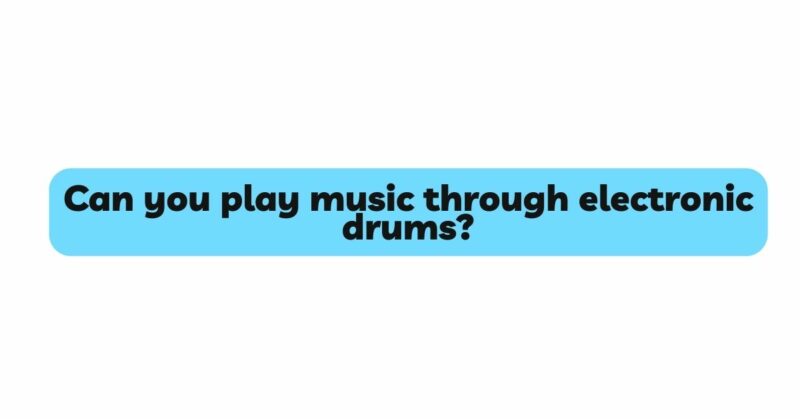In the realm of music, innovation continually shapes the way we interact with instruments and produce sound. Electronic drums, a testament to this innovation, have transformed the way drummers approach rhythm and percussion. Beyond their primary role in providing dynamic and versatile drumming experiences, electronic drums have also sparked a curious question: Can you play music through electronic drums? This article delves into the fascinating world of electronic drums, uncovering the potential, challenges, and creative outcomes of using them to play music beyond traditional drumming.
Understanding Electronic Drums
Before we delve into the intricacies of playing music through electronic drums, it’s important to comprehend the essence of these instruments. Electronic drums are modern innovations designed to replicate the sounds and feel of traditional acoustic drum kits. They consist of rubber or mesh drum pads, electronic triggers, and a sound module that generates a wide range of drum sounds.
Electronic drums offer drummers the ability to explore diverse soundscapes by triggering various percussive tones, from classic acoustic drum sounds to electronic textures. With the advent of advanced technology, electronic drum kits have evolved to provide enhanced sensitivity, dynamic range, and customization options, making them popular choices for drummers seeking versatility and adaptability.
The Idea of Playing Music
The concept of playing music through electronic drums introduces an exciting avenue of creativity. Electronic drum kits are equipped with sound modules that encompass an extensive library of sounds, including drums, percussion, synths, and more. While they are primarily designed for drumming, these sound modules can be employed to create full-fledged musical compositions.
Technically, electronic drum kits can be connected to external devices such as computers, synthesizers, and audio interfaces. This connectivity enables drummers to trigger not only drum sounds but also melodic elements, making it possible to create entire musical arrangements.
Creating Musical Arrangements
Using electronic drums to play music goes beyond traditional drumming patterns. Drummers can leverage the variety of sounds available in the sound module to construct intricate and layered musical arrangements. By triggering different sounds on various pads, drummers can simulate basslines, chord progressions, and even melodies.
Additionally, the ability to connect electronic drum kits to digital audio workstations (DAWs) opens up a world of production possibilities. Drummers can record MIDI data from their electronic drums, allowing them to edit, manipulate, and arrange musical elements within a DAW. This process essentially transforms the electronic drum kit into a versatile composition tool.
Challenges and Considerations
While the prospect of using electronic drums for music creation is exciting, it comes with its own set of challenges and considerations. One of the primary challenges is the limited number of pads available on an electronic drum kit. To create complex musical arrangements, drummers need to prioritize which sounds to trigger and when.
Another consideration is the learning curve associated with music composition. Drummers accustomed to rhythmic patterns may need to develop a new set of skills to create melodies, chords, and harmonies effectively. Familiarizing oneself with music theory and arrangement techniques can significantly enhance the quality of musical compositions created through electronic drums.
Embracing the Hybrid Approach
One approach that mitigates challenges while maximizing creative possibilities is the hybrid approach. This involves integrating electronic drums with other instruments, such as synthesizers, guitars, and basses. By incorporating external instruments, drummers can focus on what they do best—rhythmic creativity—while collaborating with other musicians to fill out the melodic and harmonic aspects of the music.
In this scenario, electronic drums serve as the rhythmic foundation, while other instruments contribute melodies, chords, and harmonies. The result is a well-rounded musical composition that blends the rhythmic intensity of electronic drums with the melodic and harmonic elements of traditional instruments.
Performance and Live Setups
Beyond music production, electronic drums can also find a home in live performance setups. Drummers can integrate electronic drums into their live shows, triggering backing tracks, samples, and even synthesized sounds during performances. This adds an extra layer of sonic depth and complexity to live performances, enhancing the overall impact of the music.
However, in live setups, considerations such as latency, sound routing, and setup logistics become crucial. Ensuring a seamless integration of electronic drums into the live performance requires careful planning, sound checks, and rehearsal to ensure a flawless execution.
Conclusion
In conclusion, the idea of playing music through electronic drums opens up a world of creative exploration and innovation. Electronic drum kits, with their diverse sound libraries and connectivity options, offer drummers the opportunity to delve into music composition and production. By leveraging the capabilities of electronic drum sound modules, drummers can create intricate musical arrangements, experiment with hybrid setups, and even enhance their live performances.
While challenges such as limited pad availability and the need for musical theory knowledge exist, they can be overcome through practice, experimentation, and collaboration. Electronic drums have proven to be more than just rhythmic instruments—they have become vehicles for musical expression and sonic experimentation, breaking down the barriers between drumming and music composition. As technology continues to evolve, the boundaries of what can be achieved through electronic drums are only expanding, inviting drummers to embark on a journey of limitless musical creativity.


